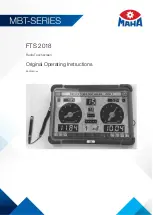
Maintenance
The controller itself requires very little maintenance. Wipe with a damp cloth. Do not spray down the controller
unless the enclosure door is closed and latched.
CONDUCTIVITY SENSOR CLEANING
The controller must be recalibrated after cleaning the sensor.
Frequency
The sensor should be cleaned periodically. The frequency required will vary by installation. In a new installation,
it is recommended that the sensor be cleaned after two weeks of service. To determine how often the sensor
must be cleaned, follow the procedure below.
1. Read and record the conductivity
2. Remove, clean and replace the conductivity sensor
3. Read conductivity and compare with the reading in step 1 above.
If the variance in readings is greater than 5%, increase the frequency of sensor cleaning If there is less than 5%
change in the reading, the sensor was not dirty and can be cleaned less often.
Cleaning procedure
The sensor can normally be cleaned using a cloth or paper towel and a mild detergent. If coated with scale,
clean with a dilute (5%) solution of hydrochloric acid solution for at least 1 minute.
Occasionally an electrode may become coated with various substances that require a more vigorous cleaning
procedure. Usually the coating will be visible, but not always.
To clean a severely coated electrodeless conductivity sensor, scrub with a toothbrush or stiff bottle brush. Soap
or hand cleaner may help. If coated with scale, clean with a dilute (5%) hydrochloric acid solution. Harsh
abrasives should be avoided. Rinse the sensor thoroughly before returning to service.
To clean a severely coated flat surface cooling tower electrode, use fine grit abrasive, such as emery paper. Lay
the paper on a flat surface and move the electrode in a back and forth motion. The electrode should be cleaned
parallel to the carbon electrodes, not perpendicular.
Cleaning a flat contacting conductivity electrode. 1. Clean in this direction.
W W W . B A L T I M O R E A I R C O I L . E U
37
6 Operating Conditions
6 Operating Conditions










































